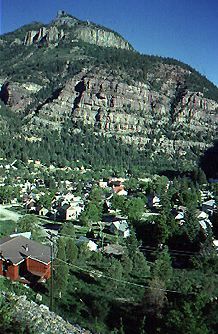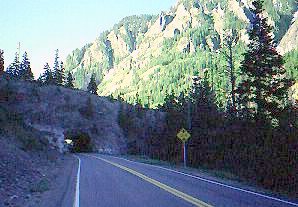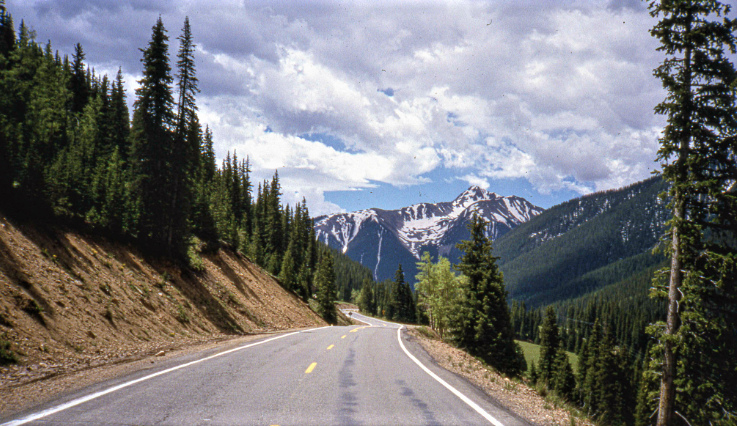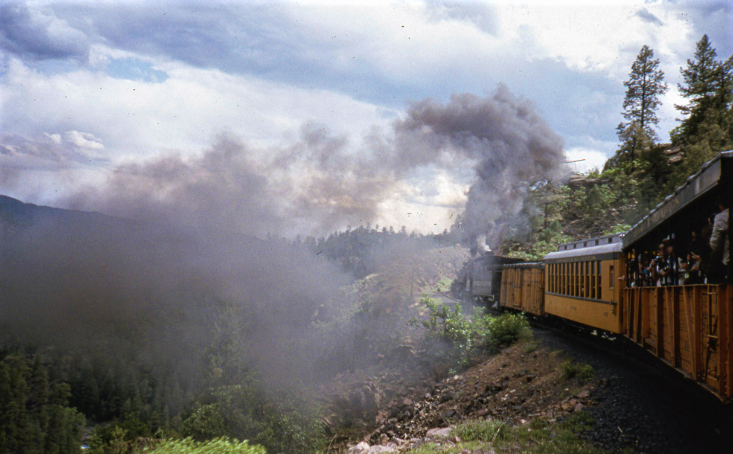Sunday, June 24, 1984
Ouray to Durango, Colo.
23 miles (by bicycle)
Locator map
I’m reprinting the day-to-day journal entries of a cross-country bike tour my friend and I took in 1984. More about the TransAmerica Tour 1984
Gene’s Journal

I can’t imagine a better day bicycling, even though it did include several hours on a narrow gauge railroad.
The climb up Red Mountain Pass is a monster. It’s a 13-mile ride from Ouray and rises from 7,706-foot elevation to 11,018 feet. Called the Million Dollar Highway (a name left over from when $1 million was a lot of dough), the climb is rated at about 8 percent. It took us 3 1/2 hours, partly because of the climb and partly because of the scenery – which we were all too happy to stop and admire as we caught our breath.
We climbed switchbacks out of Ouray, which was surrounded by lofty cliffs, and followed the roaring Uncompagre River, which had cut the hell out of these mountains. We could see old wooden miners’ cabins clinging to the mountainsides, and passed several slides where ice had recently scoured out everything in its path.

The road leveled out for a while, giving us false hope. We could see Red Mountain ahead, and started the switchbacks again. We passed the Ironton ghost town and finally reached the deserted pass where there are just a couple of small lakes. From there we raced downhill to Silverton, an old mining town that now caters to tourists and is the terminus of the Durango-Silverton Railroad.
The railroad was built in the 1880s by the Denver & Rio Grande Railroad. The tracks are laid close together (3 feet) to snake along steep canyon walls and make hairpin turns along the Animas River. The old boxcars and passenger cars are pulled by a steam locomotive, and the train still makes scheduled stops at long deserted town sites. Much of the area is actually deemed wilderness now, and several backcountry hikers onboard used it to get to their trailheads.
Smoky locomotive
We loaded our bicycles as freight to Durango and we joined the other tourists in the passenger cars. We learned that sitting close to the smoky locomotive actually was preferable to sitting in the back, where the smoke from the boiler would swoop back down to the train and get cinders in passengers’ eyes.
The train slowed to a crawl in the narrowest and steepest parts of the canyon; every coupling clanked and the yellow cars rocked side to side. After 50 miles of riding in a passenger car through wilderness flanking the Animas River, we reached Durango where we found a youth hostel. We made plans to take another rest day here for a visit to nearby cliff dwellings.
Headline: June 24, 1984 —
Countdown begins for the maiden flight
of the US’s third space shuttle, the Discovery.
(It didn’t launch until August 30 and completed 39 flights before its decommissioning in 2011.)
Bruce’s Journal
A fabulous day. We climbed 13 miles on Red Mountain Pass. There was so much to see, such amazing sights, that we didn’t even mind the climb. Once at the top, we coasted the remaining 10 miles to Silverton, ate lunch and looked around before getting on the narrow gauge train to Durango.

[Silverton could have been a back lot for some Hollywood studio. Its main street–virtually its only street–had that un-authentic Old West look that so many tourist places do, from the “Saloon” on the corner to the dirt streets, the hitching posts in front of the stores. But this place was a bona fide western town at some point in its history, and the country around it was truly spectacular. At the saloon where we ate lunch and had a beer, the piano player in the corner played the “Maple Leaf Rag.” He played it well, but too fast.]
We helped the train men, in their striped overalls and train caps, load our bikes on the box car and we settled in for a 4-hour ride through country that was accessible by foot, horse or train only. What a kick.

Mostly we followed the Animas River. The train stopped three times, once to take on water for its boiler, twice to either pick up or drop off hikers or people going to the two dude ranches located along the way. The whole trip was like taking a 100-year step back in time. The engines and track were built in the 1880s, and so were some of the passenger cars.
The train runs year-round, and is supposedly an outrageously beautiful excursion in the winter, with snow everywhere. All the brakemen, conductors and concession women are teachers in the fall and just do this part-time. [You can tell it was a labor of love.]
And really, the train is not exclusively tourist-oriented. Many people depend on the train for transportation and shipping light freight. It was quite an experience.
Once in Durango, we hit the street. This town is also much like Annapolis, but obviously with the Western motif. Nice shops and restaurants. By dumb luck we found a hostel and a bus tour to Mesa Verde, but we may have the use of a pickup truck — provided by a neighbor of the hostel who is trying to impress a solo German girl on the road. He told me we could use the truck, but the starter sticks and he needs to replace the fan belt. We may wind up on the bus after all, and I probably wouldn’t mind a bit.
We will stay another night in the hostel. We have laundry to do when we return from Mesa Verde and the cliff dwellings there. I’m looking forward to seeing those sights.
Colorado has been good to us, both in weather and in experiences. It seems like, as nice as the last state was, the next state is even better.
Tomorrow:
Day 44 — Using a pickup instead of car to Mesa Verde — bad move

Recent Comments